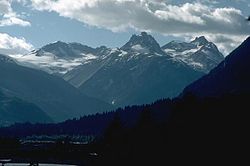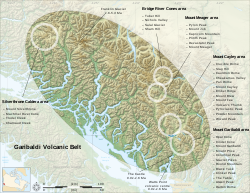The Garibaldi Volcanic Belt is a northwest–southeast trending volcanic chain in the Pacific Ranges of the Coast Mountains that extends from Watts Point in the south to the Ha-Iltzuk Icefield in the north. This chain of volcanoes is located in southwestern British Columbia, Canada. It forms the northernmost segment of the Cascade Volcanic Arc, which includes Mount St. Helens and Mount Baker.[8][9] Most volcanoes of the Garibaldi chain are dormant stratovolcanoes and subglacial volcanoes that have been eroded by glacial ice. Less common volcanic landforms include cinder cones, volcanic plugs, lava domes and calderas. These diverse formations were created by different styles of volcanic activity, including Peléan and Plinian eruptions.
Eruptions along the length of the chain have created at least three major volcanic zones. The first began in the Powder Mountain Icefield 4.0 million years ago. Mount Cayley began its formation during this period. Multiple eruptions from 2.2 million to 2,350 years ago created the Mount Meager massif, and eruptions 1.3 million to 9,300 years ago formed Mount Garibaldi and other volcanoes in the Garibaldi Lake area. These major volcanic zones lie in three echelon segments, referred to as the northern, central, and southern segments.[10] Each segment contains one of the three major volcanic zones. Apart from these large volcanic zones, two large poorly studied volcanic complexes lie at the northern end of the Pacific Ranges, namely Silverthrone Caldera and Franklin Glacier Complex. They are considered to be part of the Garibaldi Volcanic Belt, but their tectonic relationships to other volcanoes in the Garibaldi chain are unclear because of minimal studies.[7][11]
- ^ "Tricouni Southwest". Catalogue of Canadian volcanoes. Natural Resources Canada. 2009-03-10. Archived from the original on 2010-12-11. Retrieved 2010-03-04.
- ^ "Columnar Peak". Catalogue of Canadian volcanoes. Natural Resources Canada. 2009-03-10. Archived from the original on 2006-02-19. Retrieved 2010-03-04.
- ^ "Opal Cone". Catalogue of Canadian volcanoes. Natural Resources Canada. 2009-03-10. Archived from the original on 2006-02-19. Retrieved 2010-03-04.
- ^ "Mount Price". Catalogue of Canadian volcanoes. Natural Resources Canada. 2009-03-10. Archived from the original on 2009-06-28. Retrieved 2010-03-04.
- ^ "Slag Hill". Catalogue of Canadian volcanoes. Natural Resources Canada. 2009-03-10. Archived from the original on 2010-12-12. Retrieved 2010-03-04.
- ^ "Sham Hill". Catalogue of Canadian volcanoes. Natural Resources Canada. 2009-03-10. Archived from the original on 2010-12-11. Retrieved 2010-03-04.
- ^ a b "Silverthrone Caldera". Catalogue of Canadian volcanoes. Natural Resources Canada. 2009-03-10. Archived from the original on 2010-12-12. Retrieved 2010-03-04.
- ^ Cite error: The named reference
JPwas invoked but never defined (see the help page). - ^ "Garibaldi volcanic belt". Catalogue of Canadian volcanoes. Natural Resources Canada. 2009-04-02. Archived from the original on 2011-05-28. Retrieved 2010-02-20.
- ^ Wood, Charles A.; Kienle, Jürgen (1990). Volcanoes of North America: United States and Canada. Cambridge, England: Cambridge University Press. pp. 112, 113, 140, 141, 142, 143, 144, 145, 136, 137, 138, 148. ISBN 0-521-43811-X.
- ^ "Franklin Glacier". Catalogue of Canadian volcanoes. Natural Resources Canada. 2009-03-10. Archived from the original on 2010-12-11. Retrieved 2010-02-20.

